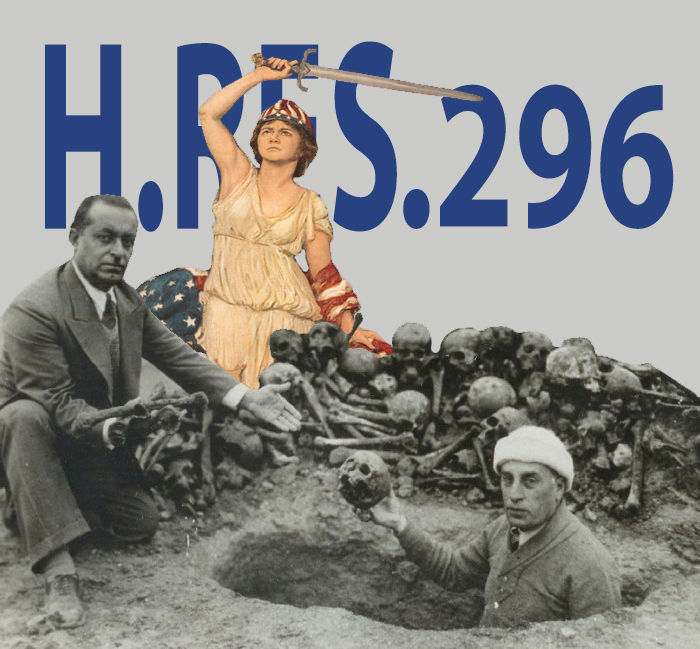

also read
Turkey, the Kurds and the Generational Trauma of the Armenians
When Turkey launched its military offensive in northeastern Syria, it triggered something in the minds and hearts and memories of many Armenians.
Read moreThe U.S. House of Representatives passed the Armenian Genocide Resolution (H.Res.296) on October 29, making it a historic day for the Armenian-American community and Armenians worldwide, who have been fighting for the international recognition of the first genocide of the 20th century.
Prior to the actual vote, the U.S. House adopted a procedural motion by a vote of 223-191 to allow consideration of the Armenian Genocide resolution. The vote on the actual resolution sent a much clearer message. After representatives from both parties rose to speak in favor of the resolution, the final count was 405 yes, 11 opposed and 3 present.
With this resolution, the United States government will not only commemorate the Armenian Genocide through official recognition and remembrance, but will “reject efforts to enlist, engage or otherwise associate the United States Government with denial of the Armenian Genocide or any other genocide and encourage education and public understanding of the facts of the Armenian Genocide, including the U.S. role in the humanitarian relief effort and the relevance of the Armenian Genocide to modern-day crimes against humanity.”
The struggle by the descendants of survivors – and victims – of the Genocide has not only been to overcome the terrible loss but also to fight for its place in the world’s collective memory.
The resolution was clearly triggered by the Turkish military invasion into northeastern Syria. It was accompanied by another resolution to impose sanctions on senior members of the Turkish government. While it ended the practice of witholding recognition of the Armenian Genocide in order to use it as a bargaining chip, the passage of the resolution will most probably be used as a tool to apply geopolitical pressure. At the same time, it would be unfair to discount the support of those in the House, who have for many years stood behind the Armenian community’s demands for recognition.
The Genocide is more than a historical factoid or raw statistics. It is embedded in the personal stories of all that it touched, including mine.
The last time I saw my father before he passed, he dragged me to his room and said he needed to talk to me. We sat across from each other silently and I could see that he was struggling. His eyes had become dull and gray as he had aged. Now there was something else, an urgent anger. I was flustered and didn’t want to listen at first. He said he needed to tell me about his mother. I told him I knew the story. He said, no you don’t. You will never know, but you must promise me that you will write about her.
I was flustered because for most of my adult life, I had been striving to write the story of his father, my paternal grandfather. It had always eluded me. I had made some feeble attempts to put pen to paper, but the words had never come out right. If I couldn’t write about him, how could I now write about her?
I never did.
My father went to his grave never reading the words that continue to spin in the dark corners of my mind, waiting to calm down so that I can line them up into cohesive sentences and find the thread to weave the narrative of her life.
A few years after my father’s death, in a moment of raw self-reflection, my mother, the daughter of an orphan from Urfa, began reminiscing about her childhood in Aleppo and later in Bourj Hammoud. At first, they were small fragments of stories: How, as a little girl, when her mother was sick, her father would help her wash the laundry by hand; How, when her young brother lost his life in an explosion, they tried to keep the news from their sickly mother; How her other brother went blind in one eye after being hit by a stone.
“….a yellow fluid started to flow and then the light ‘left his eye,’” she said, her voice breaking, her body heaving uncontrollably even though the incident had happened over 50 years ago. The deprivations, the poverty, the uncertainty she had experienced; how, at the tender age of eight, she was taken out of school to take care of her younger siblings; how she had to carry the burden of her parents’ pain… and then it struck me: it wasn’t my grandparents’ stories that I needed to tell, it was the stories of their children, the children of the survivors.
Those stories are a cornerstone of our work at EVN Report. We continue to carry all of their stories with us. Some stories were erased, forgotten, thrown on the heap of indifference by the world. Stories of parents and grandparents, communities and local cultures. Reclaiming those stories are essential to Armenia’s rebuilding process. We have to hold onto them, wear them like talismans for they are part of our DNA.
Today, the U.S. House affirmed their own story as well. House Resolution 296 ends with a promise to “encourage education and public understanding of the facts of the Armenian Genocide, including the United States role in the humanitarian relief effort, and the relevance of the Armenian Genocide to modern-day crimes against humanity.”


